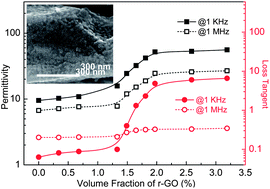Suppression of energy dissipation and enhancement of breakdown strength in ferroelectric polymer–graphene percolative composites†
Abstract
The percolative polymer composites have recently exhibited great potential in energy storage due to their high dielectric permittivities in the neighborhood of the percolation threshold. Yet high energy dissipation and poor voltage endurance of the percolative composites resulting from electrical conduction are still open issues to be addressed before full potential can be realized. Herein we report the percolative composites based on ferroelectric poly(vinylidene fluoride-co-chlorotrifluoroethylene) as the matrix and SiO2 coated reduced graphene oxide nanosheets as the filler. By capitalizing on the SiO2 surface layers which have high electrical resistivity and breakdown strength, the composites exhibit superior dielectric performance as compared to the respective composites containing bare reduced graphene oxide nanosheet fillers. In addition to greatly reduced dielectric loss, little change in dielectric loss has been observed within the medium frequency range (i.e. 300 kHz–3 MHz) in the prepared composites even with a filler concentration beyond the percolation threshold, indicating significantly suppressed energy dissipation and the feasibility of using the conductor–insulator composites beyond the percolation threshold. Moreover, these composites exhibit a remarkable breakdown strength of 80 MV m−1 at the percolation threshold, which far exceeds those of conventional percolative composites (lower than 0.1 MV m−1 in most cases) and thus enables the applications of the percolative composites at high electric fields. This work offers a new avenue to the percolative polymer composites exhibiting high permittivity, reduced loss and excellent breakdown strength for electrical energy storage applications.


 Please wait while we load your content...
Please wait while we load your content...